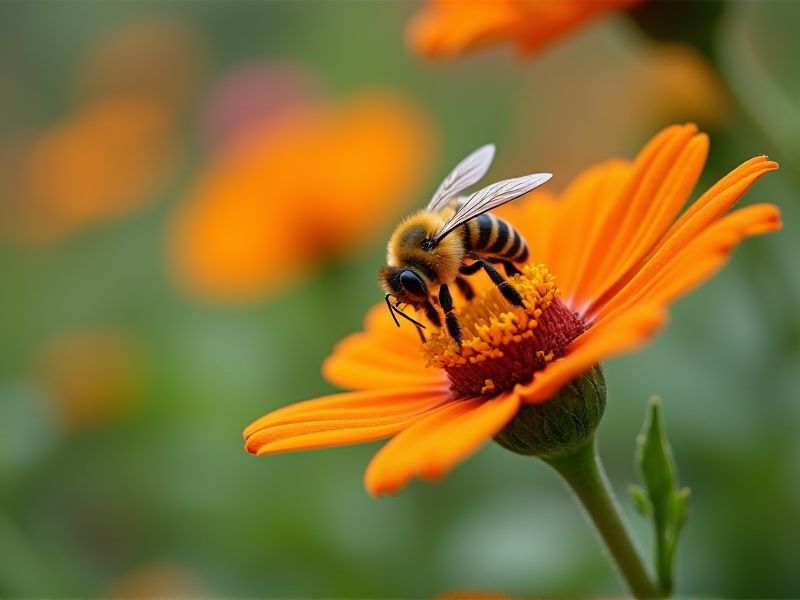
Bee-friendly plants such as lavender, coneflower, and sunflowers are essential for promoting a healthy ecosystem. These flowering plants provide nectar and pollen, essential food sources for bees, fostering their population and ensuring pollination of other plants. Incorporating native plants like wildflowers and asters can also enhance biodiversity in your garden while attracting a variety of bee species. By creating a pollinator garden with a mix of blooming times, you ensure a continuous food supply throughout the growing season. You can contribute to bee conservation by avoiding pesticides, thereby creating a safer habitat for these vital pollinators.
List of some Pollinator-friendly plants that attract bees
- Lavender (Lavandula)
- Sunflower (Helianthus)
- Coneflower (Echinacea)
- Bee Balm (Monarda)
- Borage (Borago officinalis)
- Black-eyed Susan (Rudbeckia hirta)
- Salvia (Salvia spp.)
- Goldenrod (Solidago)
- Zinnia (Zinnia elegans)
- Aster (Aster spp.)
Important things about Pollinator-friendly plants that attract bees
Native Plant Species
Pollinator-friendly native plant species play a vital role in supporting bee populations and promoting biodiversity. Flowers like Echinacea purpurea (purple coneflower) and Rudbeckia hirta (black-eyed Susan) are excellent choices, attracting various bee species with their rich nectar and vibrant colors. You can also consider planting Monarda fistulosa (wild bergamot) and Asclepias tuberosa (butterfly weed), both of which provide essential resources for pollinators while enhancing your garden's aesthetic appeal. Incorporating these native plants into your landscape not only nurtures local ecosystems but also aids in the conservation of important pollinators.
Variety Of Flower Shapes
Pollinator-friendly plants encompass a diverse array of flower shapes that effectively attract bees, enhancing local ecosystems. Tubular flowers, such as those from the trumpet vine and honeysuckle, provide easy access for long-tongued bees, while flat, open blossoms like daisies and sunflowers cater to a wide range of bee species, including honeybees and bumblebees. Furthermore, densely clustered flowers, like those of the butterfly bush and echinacea, create a visually appealing resource that invites pollinators to multiple blooms at once. Incorporating these shapes into your garden not only supports bee populations but also promotes biodiversity and a vibrant landscape.
Continuous Blooming Seasons
Selecting pollinator-friendly plants ensures a continuous blooming season that attracts bees throughout the year. Plants such as lavender, coneflower, and bee balm reliably provide nectar and pollen, supporting healthy bee populations. Incorporating a variety of species will enhance your garden's biodiversity and create a vibrant ecosystem. Consider native plants for your landscape, as they are often more resilient and well-adapted to local pollinators.
High Nectar And Pollen Production
Pollinator-friendly plants, such as lavender, sunflowers, and echinacea, are exceptional for attracting bees due to their high nectar and pollen production. These plants not only provide essential resources for bee populations but also enhance biodiversity in gardens and landscapes. By incorporating a variety of flowering species that bloom at different times, you can create a sustainable habitat that supports both local ecology and pollination efforts. Your garden will thrive with vibrant colors and invigorating fragrances while playing a vital role in nurturing essential pollinators like bees.
Colors That Attract Bees
Bees are particularly drawn to vibrant colors, especially blue, purple, yellow, and white, making these hues essential when selecting pollinator-friendly plants for your garden. Flowers such as lavender, coneflower, and sunflowers not only provide a visual feast but also serve as reliable nectar sources. The shape and structure of these blossoms are also vital, as they offer easy access for bees to collect pollen and nectar efficiently. By incorporating a variety of these colorful plants, you can create a thriving habitat that supports bee populations while enhancing the beauty of your outdoor space.
Clustering Plants Together
Planting pollinator-friendly plants is essential for attracting bees and supporting biodiversity in your garden. Consider incorporating perennials such as coneflowers, black-eyed Susans, and bee balm, which provide vital nectar and pollen sources. Grouping these plants in clusters enhances their visibility and facilitates foraging by pollinators, creating a vibrant and lively garden space. By cultivating a diverse array of flowering plants, you can help sustain local bee populations and promote a thriving ecosystem.
Avoidance Of Pesticides
Creating a pollinator-friendly garden involves planting native flowers that naturally attract bees while avoiding harmful pesticides. Consider incorporating plants like milkweed, coneflowers, and lavender, which promote bee health by providing nectar and pollen sources. By opting for organic gardening practices and embracing the use of companion planting, you can enhance biodiversity and support local bee populations without exposing them to chemical toxins. This proactive approach not only nurtures your garden but also contributes to the overall health of the ecosystem.
Bee-Friendly Groundcovers
Bee-friendly groundcovers are essential for creating habitats that attract and sustain pollinators in your garden. Varieties such as Creeping Thyme, White Clover, and Sweet Woodruff are excellent choices due to their vibrant flowers and low maintenance requirements. These plants not only provide nectar and pollen for bees but also support biodiversity by creating a lush environment. Incorporating these groundcovers into your landscape can enhance the aesthetic appeal while playing a crucial role in supporting local bee populations.
Providing Shelter And Habitat
Pollinator-friendly plants such as lavender, echinacea, and sunflowers are essential for attracting and sustaining bee populations in your garden. These plants offer nectar and pollen, which are crucial food sources for various bee species, including honeybees and native bumblebees. Incorporating a diverse range of flowering plants that bloom at different times throughout the growing season can help create a stable habitat, enhancing your garden's biodiversity. Creating a pollinator-friendly space also involves minimizing pesticide use, ensuring a safe environment for bees to thrive and prosper.
Supporting Local Ecosystems
Pollinator-friendly plants, such as native wildflowers and herbs, enhance local ecosystems by providing essential food sources for bees and other pollinators. Plants like lavender, echinacea, and sunflowers are rich in nectar and pollen, crucial for bee health and biodiversity. Creating a diverse garden with varied blooming periods ensures year-round support for these vital insects. By incorporating these plants into your landscape, you contribute to the sustainability of pollinator populations and foster a thriving ecosystem.
